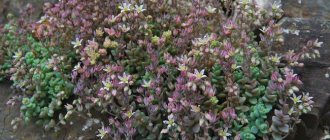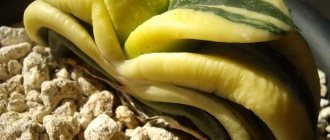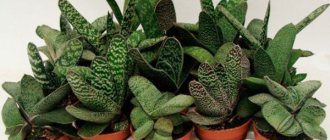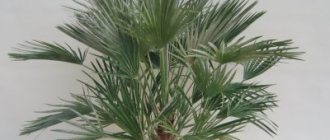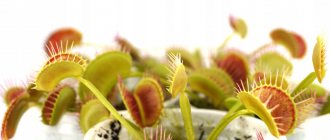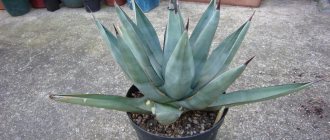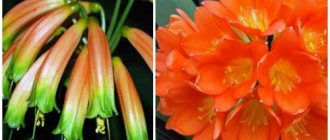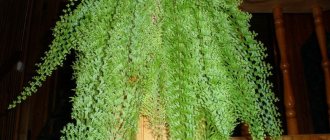Description and origin of gasteria
The genus Gasteria contains 26 species of gasteria. On their basis, about 100 hybrids have been bred through selection. The ancestral home is South Africa. These are succulent herbaceous perennials. In almost all varieties, the leaves grow in a spiral. Over time, a rosette with leathery leaves up to 10 cm long is formed. The total height of the bush rarely exceeds 20 cm.
In the wild, it quickly reproduces by daughter rosettes. As a result of fairly rapid spread, it forms extensive clumps. Blooming clumps are a picturesque sight. Numerous inflorescences of delicate shades are attached to a single peduncle. The bell-shaped buds open at dawn and close towards sunset.
Features of the plant
Gasteria is native to South Africa. Like other desert plants, gasteria is capable of storing water “in reserve” - like a camel. But you need as much sun as possible, but without direct sunlight.
The plant is easily recognized by its fleshy, tongue-shaped leaves (with a pointed or rounded shape), but in nature there are more than 80 species of this flower. But if we talk about gasteria as a houseplant, then about 10 varieties are bred. The most common “representatives” of the family are warty, Amrstrong, spotted and dwarf.
Regardless of the species, this is a small flower. The leaf size can reach from 10 to 30 cm, depending on the variety. Gasteria grows slowly and is in no hurry. It is also unpretentious, which makes the plant convenient for growing in an apartment. Even novice gardeners can easily cope with such an unpretentious “pet”.
When people talk about the Gasteria plant, they most often mean the “warty” variety. This succulent looks cute: on the long tongue-shaped leaves there is a scattering of snow-white spots reminiscent of warts. The stems are pleasant to the touch. The length of the leaves is about 15-20 cm.
How to grow gasteria?
Keeping it at home will not cause much trouble. It is enough to provide comfortable conditions and follow the rules of care.
Lighting
You can keep a flower pot with a succulent on any windowsill. However, you should know that northern windows do not contribute to the appearance of ovaries. The ideal directions for abundant flowering are western and/or eastern.
What to do if the room does not have access to the west or east? Ultraviolet deficiency can be compensated with the help of a phytolamp. At the same time, experts insist: the lamp power must be at least 6500K. Lower values are not able to stimulate the release of the peduncle.
Irrigation
The South African is not prone to excessive water consumption. The main thing in caring for gasteria is to monitor the condition of the soil. Once the soil is completely dry, water the flower generously. Remember, excess moisture is an enemy that can quickly destroy roots. How to determine the condition of the soil? Watering time is approximately 3 days after the top layer of soil has dried.
In winter, the amount of watering should be reduced to the required minimum. As soon as the central heating comes on, additional humidification will be required. A household humidifier will help with this. The simplest alternative is a damp layer of pebbles at the bottom of the pot.
Air temperature
Temperature indicators do not play a special role in the life of an adult specimen. But kids will need special conditions. Optimal limits: in summer – within +27°, in winter – from +10° to +15°.
Fertilizers
Of course, the best and easiest way is to use specialized industrial fertilizers. They are developed taking into account all requirements and contain all the necessary microelements. It is enough to follow the manufacturers' instructions.
Before and during flowering, give preference to nitrogen-potassium compounds. The presence of phosphorus is welcome. The dosage is calculated individually, depending on the age of the plant. The younger the flower, the more often you need to fertilize. The first application is the end of February, beginning of March. The last one is the third ten days of August.
Botanical description
Gasteria (lat. Gasteria) is absolutely unpretentious and can be easily grown at home, even with minimal care. The main distinguishing feature of the plant is the swollen lower part of the perianth tube.
Botanical description of the culture:
- The leaves are long, dark green with cream or yellow spots and stripes, and have a hard, smooth or rough texture.
- The stem is very shortened or absent.
- The rosette is dense, two-row, and over time begins to twist in a spiral.
- The flowers are yellow, red or greenish in color, on a long peduncle, the buds are shaped like a wine amphora.
- The root system is branched and superficial.
- The height of the plant is up to 25 cm, the peduncle reaches 40 cm.
How to propagate gasteria by seeds
If you decide to harvest your own fruit, prepare in advance. Tap the peduncle with a wooden stick every day. This is a great way to help your pet self-pollinate. And be sure to let the fruit dry on the branch! What to do next?
- Open the seed pod and collect the seeds.
- Soak the seed first in a very weak manganese solution. After 2 hours, pour the seeds with a growth stimulant diluted in water.
- Prepare a container with coarse sand. Moisten the sand well. Sow the seeds over the surface without digging.
- Close the mini greenhouse tightly with any transparent material. Place in a warm, well-lit place. The temperature inside the greenhouse should not drop below +25°. Daylight hours are at least 16 hours.
- After 3 days, start opening the container every day for 5 minutes (for ventilation). Keep the sand semi-moist.
- Two weeks after germination, remove the roof completely. And after another 2 weeks, transplant the seedlings to a permanent place of residence.
Gasteria nigricans f. monstrosis (Gasteria nigricans f. monstrosa)
Description: Dark green, small, asymmetrical rosettes collected in a dense group. Height, depending on the clone, 2-10 cm, leaf thickness 0.2-2 cm. May change in appearance as it grows.
There are also very large gasteria, reaching a diameter of 40 centimeters or more, such as Gasteria trigona and Gasteria obtusifolia.
Intraspecific or intergeneric hybrids between Aloe, Gasteria, Haworthia
Gastrolea beguinii Gasterhaworthia rosava
Intergeneric hybrids are known, for example, a hybrid between Gasteria and Aloe, called Gastrolea; there are over 20 different forms. There are hybrids between Gasteria and Haworthia - Gasterhaworthia. Aloeworthia is a hybrid of haworthia and aloe. Aloe, Haworthia and Gasteria are closely related enough to easily form numerous intergeneric hybrids. It is also easy to obtain intrageneric hybrids, for example between different species of haworthia or aloe. Dozens of such varieties are known, and more and more are constantly appearing. Externally, the plants are intermediate between the parents. For example, at first the plant may behave like a Gasteria, but quickly forms a twisted rosette. Or a plant similar to Haworthia blooms with orange swollen flowers, indicating its hybrid origin. Due to their participation in crossing relatively large aloe, hybrids often turn out to be relatively massive and quite fast-growing. The history of some famous hybrids goes back hundreds of years: with the development of decorative floriculture in Europe and the long existence of vegetatively maintained collections.
Gasteria in indoor floriculture
Gasteria nigricans monsterosa
These are less demanding plants than aloe and haworthia. They tolerate full sun well, although they can grow in partial shade. In the spring, some of them may suffer from too sudden an increase in light levels and their leaves may turn red. Later, in the summer, they acquire their former green color. The thicker skin of the leaves gives them some protection from insect pests. In winter, plants are kept at a temperature of 8-10ºС; in summer they can be placed on eastern and southern windows. Water moderately in winter, and in summer - as the earthen clod dries out. Gasteria are resistant to dry air and do not need spraying, but in winter they suffer if the room is too warm and dry. Gasteria, like most other succulents, is a plant with a CAM type of photosynthesis; it absorbs carbon dioxide and releases oxygen at night (although photosynthesis itself occurs during the day). In this regard, it is recommended to keep gasteria in sleeping areas. Transfer
Gasteria are replanted in the spring: young plants annually, mature ones after 2-3 years, it is important to provide a good drainage layer. Reproduction. Gasteria are propagated by seeds, side shoots (babies), and leaf cuttings. In indoor culture (temperate latitudes), gasteria reproduces vegetatively
The root shoots are separated from the mother plant and rooted in a mixture of turf soil and humus with the addition of a sand and gravel substrate. Rooting takes from a week to a month, depending on the type of plant and external conditions. In more southern latitudes, gasteria are also propagated by seeds. Pests and diseases. They can be damaged by scale insects, spider mites, and aphids. Inspect your gasteria regularly for these pests.
- Succulents
- Aizovye
- cacti
- Lastovnevye
- Euphorbia or Euphorbia
- Sanseviera
- Agave
- Aloe
- Haworthia
- Family Crassulaceae (various types of families)
- Anacampseros
- Ragwort
- Succulents (various other genera)
Other methods of propagation of gasteria
- Propagation by rosettes is the easiest way. Carefully separate the baby that appears at the base of the bush and transplant it into a separate bowl. The main thing in separation manipulations is not to damage the delicate roots. Experienced flower growers advise separating daughter rosettes as early as possible. The younger the plant, the easier it adapts after stress.
- Leaf cloning is a completely possible option. But the effectiveness of this method is quite low. Only 4 out of 10 cut leaves produce roots. It is recommended to powder the leaf cut with Kornevin and leave it to dry for a couple of days. Plant first in wet sand.
Diseases and pests
Gasteria is susceptible to fungal infections , which appear as black spots on the leaves.
Overwatering and using cold water can cause root rot :
- leaves become flabby
- the base of the socket softens,
- the roots become brown.
At the first signs of wilting, you need to check the soil moisture and replant the succulent in dry, clean soil.
Pests: spider mites, aphids, scale insects.
How to identify root and stem rot in succulents and save the plants
Possible gasteria problems
Succulent belongs to the category of resistant plants. This means that if the basic conditions are met, he practically does not get sick. Serious problems can arise only in two cases:
- Overmoistening of the soil. The consequences are catastrophic: from the appearance of root rot to rotting of the stems. At the same time, the plant does not give distress signals until the last moment. How to resuscitate? Clean the trunk and stems from rot. Wash, dry and bury in sand until new roots appear.
- Infection. The disease signal is brown dots or cobwebs on the inside of the leaf. The source of infection can be either the substrate, or, more likely, a diseased plant in the neighborhood. And in either case, the bush and soil should be treated with appropriate preparations. It is better to use systemic fungicides with a universal spectrum of action (Fitosporin, Alirin, etc.).
Suitable conditions
Gasteria loves light. But she needs special lighting - soft, indirect. But aggressive sun rays spoil the appearance of the plant: the design is lost. A suitable option is a south or southwest window sill.
For the autumn-winter season, you can create artificial lighting for the flower. Fluorescent lamps are suitable (distance 30-50 cm). Illumination duration is about 8 hours.
Care in room conditions also implies an appropriate temperature. The plant feels great in a city apartment. True, in winter the flower should be moved away from the radiator - the gasteria will be more comfortable near the window glass. But you can’t freeze the stems either. Frosty air when ventilated can harm the plant.
If you want gasteria to bloom, you need to provide a period of rest in winter. You should take care of a special temperature regime - within + 6-12 ° C. Then the flowering will be long and abundant. If in cold weather the flower is at +15, the inflorescences may dry out without leaving the rosette.
Popular types and varieties
Let's look at the most common and popular varieties and varieties. Photo, title, description:
- Gasteria maculata is a beautiful variety with leaves that grow in a fan shape. It is distinguished by its rich leaf color and smooth surface. The flowers are bright red and reach a length of 3 cm.
- Gasteria Armstrong (G. armstrongii) is a dwarf species. A fleshy plate up to 5 cm wide grows no more than 10 cm in length. One bush produces only one peduncle per season, on which up to 10 buds can be located.
- Gasteria verrucosa (G. Verrucosa). So named because of the large number of convex white seals. Grows 20 cm in height. Blooms in spring.
- Gasteria Little Warty is a hybrid variety bred in the middle of the last century. A compact bush up to 8 cm high produces bright pink flowers. Propagated only by daughter rosettes. When propagated by seeds, it loses its characteristics.
Growing and care
Watering
Before watering, the soil must be completely dry.
The plant is quite resistant to tap water, but it is recommended to stand for it.
Do not get water on the leaves.
Top dressing
Ready-made mineral mixtures for cacti and dracaenas are used as feeding. The recommended dose is divided in half.
- spring-summer: every 3rd watering;
- autumn-winter: do not feed.
Bloom
The succulent blooms in spring or summer - on a long (up to 40 cm) peduncle, bright buds open, similar in shape to an amphora or stomach. Flowering continues for more than a month; several flower stalks can grow on one plant.
Gasteria flower stalks @Reggie1, Flickr
Gasteria flowers @Skolnik Co, Flickr
Rest period
In winter, it is advisable to place plants in a bright, unheated room with a temperature of +7..12 degrees. If you do not provide the flower with a cold winter, there is a high probability that it will not bloom in summer.
Watering at this time almost completely stops (a small amount of water once a month).
Main types
Almost all types of catharanthus have similar features and properties, namely:
- strong trunk and increased branching. Greenish shoots sometimes have a pink tint;
- shiny green foliage with beige veins, short petioles;
- average bush height 1 m;
- The 5-petal flower is white or burgundy in color.
Catharanthus flower
Below are the main types of culture.
Periwinkle catharanthus
Periwinkle catharanthus is a deciduous subshrub, the height of which on average is up to 1 m. The flower is classified as a number of small plants, but in optimal conditions it can grow up to one and a half meters. It is usually grown from seeds. When planting catharanthus in the last days of winter, the plant will bloom from late spring until autumn.
For your information! Today, catharanthus hybrids are being actively developed, the flowers of which have white, pink and red cores.
Catharanthus pink
Pink catharanthus is intended for growing at home. In the tropics it grows more actively (there its height reaches 1.5 m); in Russia, the height does not exceed 1 m. The 7-centimeter lanceolate leaves in the center have a characteristic beige vein. The edges of the foliage are quite smooth, the surface is glossy. Flower color varies depending on the variety. Flowering is long-lasting and largely depends on maintenance conditions, weather and climate. At low temperatures, flowering lasts about six months. In warm climates, the catharanthus flower can bloom throughout the year.
Catharanthus bush
Catharanthus bush is a compact plant with large dark green leaves and bright, rich 5-centimeter flowers. This species is suitable for growing indoors, on a balcony, loggia, or can be used to decorate flower beds. This type is transportable, so it is perfect for sale.
In addition to the above types of catharanthus, there are also the following:
- hanging - Cascade, Mediterranean;
- Aristocrat;
- Pacific;
- Pacific Burgundy;
- Pacific Epricot;
- Pacific White;
- First kiss.
Propagation of indoor plants by cuttings
Propagation by cuttings (vegetative method) is the most popular among gardeners. A cutting is a part of a plant that is specially cut off. It has the ability to take root and grow. In floriculture, there are several different types of cuttings, namely: stem, leaf, apical, and middle.
Propagation by apical cuttings
This method is used for all hanging plants, as well as impatiens and impatiens.
To obtain this kind of cutting, the part of the non-lignified stem that is located at the top is cut off. Such a cutting must necessarily have developed leaves in an amount of 2 to 4 pieces. You need to step back a centimeter below the node and make a cut. It is at this node that roots appear first. To make rooting faster, it is recommended to treat the cut with growth stimulating agents (phytohormones).
For rooting, the cuttings are planted in a mixture for young plants and then watered. To maintain humidity at a high level, the container is covered with film.
HOW TO PROPAGATE PLANTS BY TERMAL CUTTINGS?
Watch this video on YouTube
Propagation by stem cuttings
Ficus, geranium, all succulent plants, as well as cacti can be propagated by stem cuttings.
This type of cutting can only be cut from a healthy plant, and the cut should be made slightly below the node. Such a cutting should consist of 3 or 4 nodes and there should be leaves on it
Pay attention to the cut, it should be fresh and even. There should be no flowers or buds on the cuttings
If desired, the leaves located below can be torn off. Rooting is done in moist soil that contains a lot of sand, or a soil mixture for young plants is used for this. After the roots appear (after about 3–4 weeks), the plants are transplanted into a regular soil mixture. Most cuttings are rooted by simply dipping them in a glass of water.
If you propagate succulent plants or cacti in this way, then the cutting must be left for several days in the open air to dry before planting for rooting. The cut area should become tight, and its edges should bend inward. This will prevent the occurrence of stem rot. After planting, the soil is slightly moistened with a sprayer (do not water).
Cuttings of geraniums, as well as succulent plants, are not covered with film during rooting. All other plants need high humidity at this time, so they need to be covered with film.
As a rule, it is recommended to place the cuttings in a well-lit and fairly warm place. It should be noted that they must be protected from direct sunlight.
As a rule, such cuttings are propagated in spring and summer, when the plant grows intensively. But there are plants that are best propagated in this way in the last days of summer, for example, geranium, fuchsia.
The middle cutting is considered part of the stem. Cut it from the middle or lower part of the shoot. As a rule, such cuttings are used to propagate Tradescantia.
Propagation by leaf cuttings
Bushy begonia, gloxinia, Usambara violet (Saintpaulia), and peperomia can be propagated by leaf cuttings.
Propagation of Saintpaulia is carried out using whole leaf blades with cuttings. A strong, healthy leaf with a stalk of decent length should be cut from the plant, then it is planted in a special soil mixture. When daughter plants form on the leaf blade, they will need to be separated and planted separately.
Succulent plants are propagated directly by leaf blades. So, for the propagation of streptocarpus, sansevieria and gloxinia, part of the leaf is used. It is necessary to plant the leaf in the soil in such a way that only a small part of the leaf rises above the soil surface. In the case when the particles of the leaf plate are too small in size, they are laid out on the surface and lightly pressed into the substrate.
Propagation of gloxinia by leaf cuttings or leaf fragments
Watch this video on YouTube
